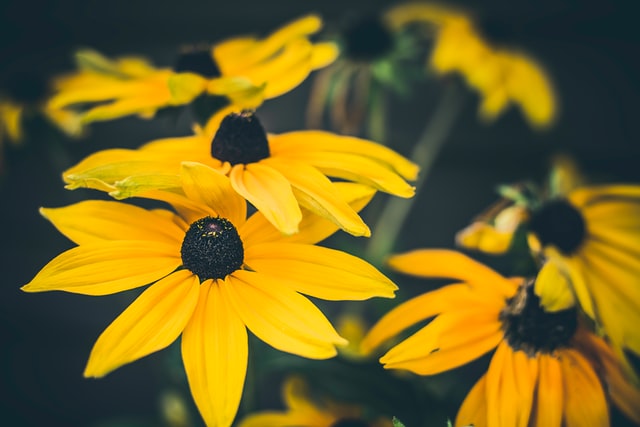Planting a garden together with your kids offers so many benefits. Gardening can teach kids responsibility and help them learn more about nature, all while providing an opportunity for family bonding. Also, watching work blossom can be an amazing feeling for kids and adults alike.
However, if you’re not sure which plants will thrive where you live, starting a garden can feel like a daunting experience. That’s where Crème de la Crème of Sugarloaf (Duluth) comes in. To get you started, we’ve put together this guide for planting low-maintenance gardens right here in Duluth.
Choosing Plants for Duluth Gardens

“close shot of yellow flowers” used with permission via Unsplash by owenyoungg
Duluth families looking to get into gardening are in luck. The city is located in zone 7b of the USDA Plant Hardiness Zone Map, which means you’ll have tons of options for plants. There’s a reason your gardening activities here will be exciting. Unlike in more northern areas of the United States with regular cold winters or areas further south occasionally with intense summer heat, here you’ll get to think mostly about aesthetics when you’re choosing plants for your garden.
Many plants don’t like extreme weather, be it too hot or really cold. However, zone 7 is comfortably between the extremes of heat and cold, so you’re free to pick a variety of plants as you please. You’ll get to choose from classic perennials, bulb plants, ground covers, ornamental grasses, and foliage plants. Duluth also favors many species of vegetables and more if you want to cultivate some edible plants with the kids.
Growing Flowers and Ornamental Plants in Duluth
Here are some beautiful options for your backyard garden:
Black-Eyed Susan
Black-eyed Susan is a long-blooming perennial that adds a lovely touch to any Duluth garden. You won’t need to take much time irrigating these plants, as they’re drought-tolerant. The plant does tend to spread, though, so keep in mind that you might need to pull it here and there if it gets into areas where you don’t want it.
Plant Black-eyed Susan in dry to medium, well-drained soil and full sunlight, then enjoy the elegance it brings.
Butterfly Weed
Asclepias tuberosa, better known as butterfly weed, is your surefire trick to bringing butterflies to your garden. Plant a few together with your kids where you want to bring the butterflies, then watch as these amazing creatures visit your backyard. Once established, butterfly weed is drought-tolerant. If you don’t take off the seed pods once it flowers, it may also just spread naturally.
For the best result, plant it in full sunlight and well-drained soil.
English Lavender
English lavender is a Mediterranean plant perfect for Duluth growers who can’t commit too much maintenance time. Just put it in dry to medium soil that drains sharply and is exposed to sunlight. Once these two conditions are met, you can expect gorgeous purple sight and a delightful scent near your home.
Hosta
Hosta, or Plantain Lily, is a popular choice for gardeners looking for outdoor foliage options. This plant is easy to grow (as long as you keep slugs and deer away) and offers a range of colors and sizes to pick from. You can use this plant as a backdrop for other plants or as an edging plant. Put it in well-drained soil and partial to full shade.
Maiden Grass
Ornamental grasses are another superb choice for a perennial garden, and Maiden grass produces some of the best results. Graceful and tall, Maiden grass offers winter interest if you wait to remove old stems until the spring. The coppery grass likes full sun and well-drained soil, though it can tolerate clay soil reasonably well.
Spotted Joe-Pye Weed
Spotted Joe-Pye weed provides the perfect solution if you want to go for a sequence of blooms. The tall plant adds a stately charm to the back row of your garden when it blooms later in the summer season. This plant’s main need is evenly moist soil — it’s a wetlands plant in the wild, after all. Plant it in partial shade for best results in zone 7.
Victoria Blue Salvia
“Victoria Blue” Salvia, or Mealy-Cup Sage, needs to be grown as an annual in the North. Not so in Duluth, since this plant is cold-hardy in zone 7. The plant will bring striking blue flowers to your backyard garden. That said, you’ll want to keep it in full or partial sun and ensure you plant it in well-drained, evenly moist soil. You should also deadhead the flowers to encourage more blooming and better freshness.
Yellow Alyssum
Yellow Alyssum is a ground cover that is perfect for growing behind a retaining wall. Trailing stems and vibrant yellow flowers brighten up walls and rock gardens. And as long as you plant Yellow Alyssum in soil with good drainage, it should grow nicely. This plant thrives in poor soil and full sunlight.
Growing Edible Plants in Duluth
A variety of easy-to-grow vegetables will thrive in Duluth gardens, too. Planting things you can eat with the family is a great way to get the kids involved with mealtime from start to finish. The personal experience can even inspire children to try out new veggies they might otherwise avoid.
You may hesitate, especially if you’re just starting out, to grow vegetables if you think they’re hard to care for. Fortunately, you’ll find many edible plants that are simple to grow in Duluth throughout the year. These plants all have a reputation as being easy to grow, no matter your skill level:
- Beets
- Bell peppers
- Carrots
- Cucumbers
- Green beans
- Kale
- Lettuce
- Peas
- Radishes
- Spinach
- Swiss chard
- Tomatoes
- Zucchini
There you have it. Crème de la Crème of Sugarloaf (Duluth) just gave you various flowers, vegetables, and more to grow at home. Do you have a favorite plant that thrives in your backyard that we didn’t include in this guide, perhaps one that other local families just have to consider for own garden? Drop us a line if we missed a must-have plant for Duluth gardens so we can add it here.
